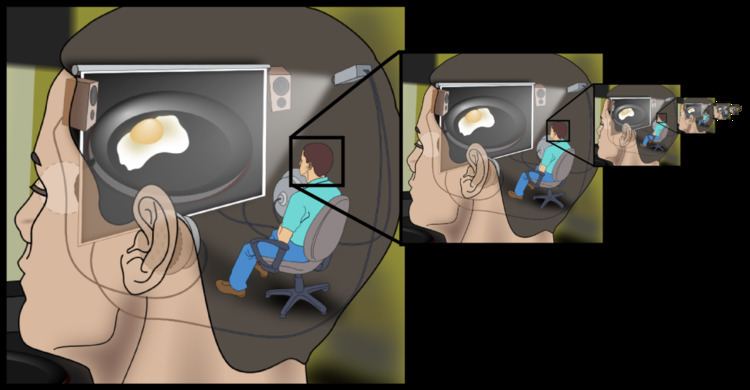 | ||
The homunculus argument is a fallacy arising most commonly in the theory of vision. One may explain human vision by noting that light from the outside world forms an image on the retinas in the eyes and something (or someone) in the brain looks at these images as if they are images on a movie screen. The question arises as to the nature of this internal viewer. The assumption here is that there is a little man or homunculus inside the brain "looking at" the movie.
The fallacy can be seen by asking how the homunculus "sees" the internal movie. One answer is that there is another homunculus inside the first homunculus's head who is looking at this second movie. But how does this homunculus see the world? This requires the positing of another homunculus inside this other homunculus's head, and so forth, creating an infinite regress. The problem with the homunculus argument is that it tries to account for a phenomenon in terms of the very phenomenon that it is supposed to explain.
The "movie screen" theory of vision is sometimes termed the theory of the Cartesian Theater. It is most associated, nowadays, with the psychologist David Marr.
Homunculus arguments in terms of rules
Another example is with cognitivist theories that argue that the human brain uses 'rules' to carry out operations (these rules often conceptualised as being like the algorithms of a computer program). For example, in his work of the '50s, '60s and '70s Noam Chomsky argued that (in the words of one of his books) human beings use Rules and Representations (or to be more specific, rules acting on representations) in order to cognate (more recently Chomsky has abandoned this view: c.f. the Minimalist Program).
Now, in terms of (say) chess, the players are given 'rules' (i.e. the rules of chess) to follow. So: who uses these rules? The answer is self-evident: the players of the game (of chess) use the rules: it's not the case (obviously) that the rules themselves play chess. The rules themselves are merely inert marks on paper until a human being reads, understands and uses them. But what about the 'rules' that are, allegedly, inside our head (brain)? Who reads, understands and uses them? Again, the implicit answer is (and, some would argue, must be) a 'homunculus': a little man who reads the rules of the world and then gives orders to the body to act on them. But again we are in a situation of infinite regress, because this implies that the homunculus has cognitive process that are also rule bound, which presupposes another homunculus inside its head, and so on and so forth. Therefore, so the argument goes, theories of mind that imply or state explicitly that cognition is rule bound cannot be correct unless some way is found to 'ground' the regress.
This is important because it is often assumed in cognitive science that rules and algorithms are essentially the same: in other words, the theory that cognition is rule bound is often believed to imply that thought (cognition) is essentially the manipulation of algorithms, and this is one of the key assumptions of some varieties of artificial intelligence.
Homunculus arguments are always fallacious unless some way can be found to 'ground' the regress. In psychology and philosophy of mind, 'homunculus arguments' (or the 'homunculus fallacies') are extremely useful for detecting where theories of mind fail or are incomplete.
The homunculus fallacy is closely related to Ryle's regress.
